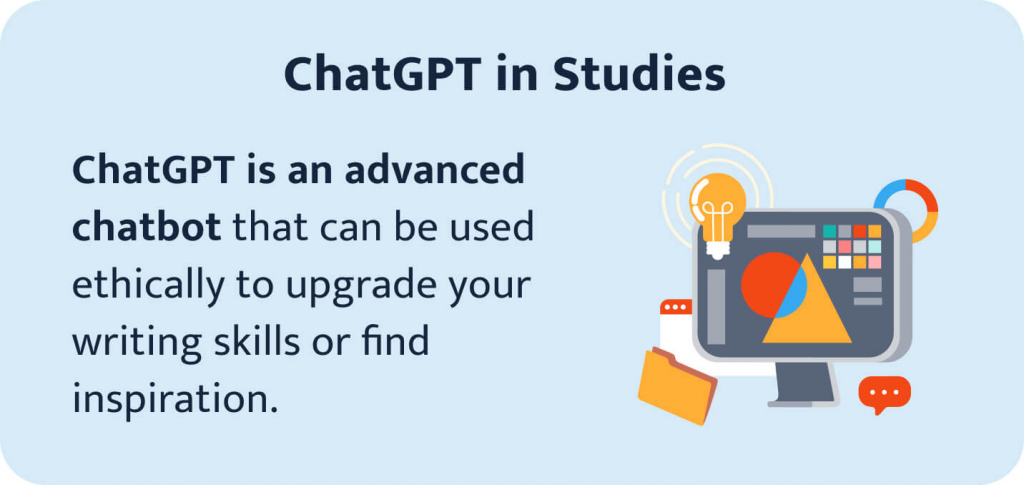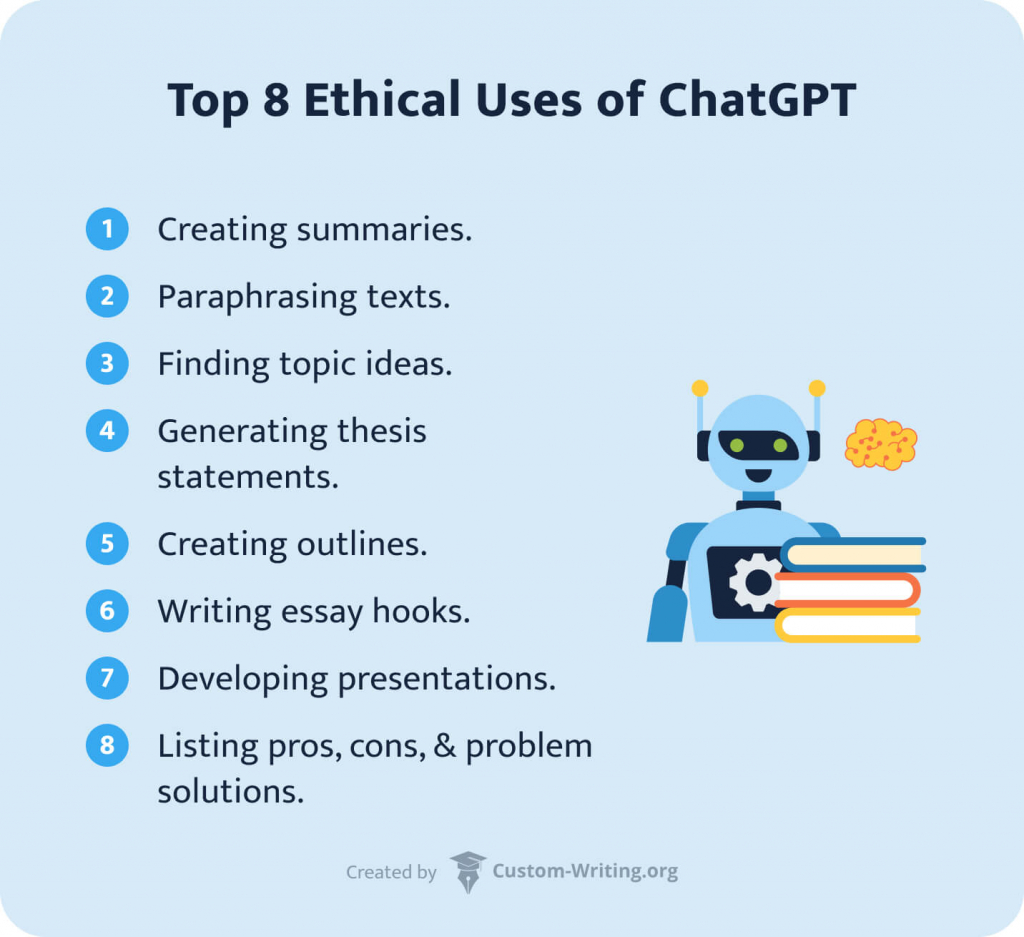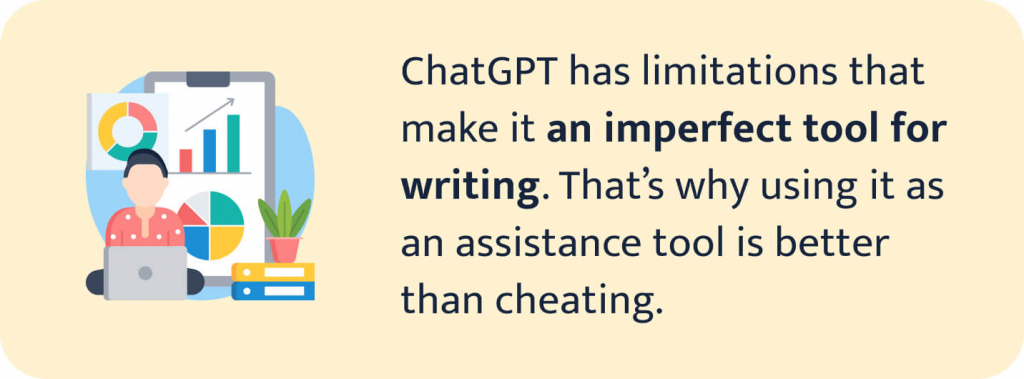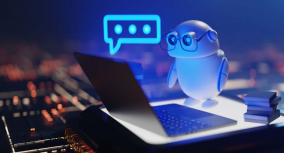The trend of introducing AI to education is met with two types of reaction. Some are excited by the possibilities, and others are worried by the potential threats to the education system.

At the center of debate is ChatGPT—an advanced chatbot that produces incredibly well-written texts. The temptation may be strong to use the content it generates for cheating. But here’s a better idea: apply ChatGPT ethically to upgrade your writing skills or find inspiration.
Want to know how? This article by our custom-writing team has the answer! Stick around for 8 fair ways to use ChatGPT in your studies.
✨ Ethical Considerations of Artificial Intelligence in Studies
Every breakthrough invention raises ethical concerns, and ChatGPT is no exception. So, let’s see how AI is misused in education, and what the implications are.
The unethical application of artificial intelligence in academia usually comes down to one thing—plagiarism. When there’s zero input on behalf of the student, what’s the point of academic writing? If an all-knowing AI is a few clicks away, does studying make any sense?
Some teachers are panicking about the possible negative effects of artificial intelligence in education, even going as far as blocking access to ChatGPT for their students. It’s an understandable kneejerk reaction that doesn’t really solve anything since students can still use the chatbot outside the classroom.

But why focus only on the negative impact of AI tools? If we pause for a second, silence our biases, and look at the matter from a different angle, we’ll see countless benefits of an AI chatbot in education. Here are just some of them:
And there are many more benefits of artificial intelligence in education, which you can read about in our article on ChatGPT in academic writing.
So, why shy away from it? We suggest you use the power of AI to your advantage—keep reading to learn how!
🖥️ ChatGPT Basics: How to Write Perfect Prompts
Simply speaking, prompts are phrases that contain your requests. Writing efficient prompts is the first thing you have to master if you want to use ChatGPT to the full extent. AI or not, it is still only a chatbot, and it requires clear and understandable instructions to give you what you want.
Here’s what you should keep in mind when writing prompts:
Let us demonstrate what we mean by “a good prompt.” Below you will see a few examples of a bad request and its improved version. We’ve also added search intent for each case to reflect the result you want from the tool.
🤩 Top 8 Ways to Use ChatGPT in Studies Without Cheating
Knowing how to write excellent prompts is great, but it’s not enough to harness the power of AI! You also need to know when and how to use it in your studies to get the best results.
So, it’s time to look at our ultimate list of ways to use ChatGPT ethically.

1. Creating Summaries
Hands down, one of the best uses for ChatGPT is summarizing texts. We’re not talking about letting ChatGPT do your homework! We’re talking about using summarization as a means to facilitate access to enormous amounts of information the world is throwing at us.
Just imagine that a long, tedious, and complex text you’re reading can instantly become shorter and easier to understand without losing its substance. That’s what ChatGPT is surprisingly good at.
It uses both extractive and abstractive text summarization techniques and produces natural and accessible texts with all the necessary clichés. It can rephrase sentences and distinguish between primary and supplementary ideas.
We have a few tips for you to get the best summaries out of ChatGPT:
2. Paraphrasing Texts
Paraphrasing can also be mentioned among ChatGPT’s many talents. This tool is fantastic when it comes to readability. It is also good at finding words that fit the context and changing sentence structures.
This feature can come in handy if you need to quote someone indirectly in your essay or research paper. We recommend you check out this article on indirect quotations by ThoughtCo to learn more about this process.
When paraphrasing via ChatGPT, be mindful of the following for the best results:
3. Finding Topic Ideas
If you’ve run out of inspiration, you can turn to ChatGPT for help. Don’t worry: asking it to generate a few ideas for an essay is not cheating!
ChatGPT is an almost inexhaustible source of ideas on nearly any topic. Here are a few things to remember:
4. Generating Thesis Statements
If topics don’t get your creativity going, you can jump straight to generating thesis statements. They will be well-formulated and contain at least 3 main arguments.
The guidelines are the same as with the topics—just type in “generate an essay thesis on [topic].” Here are some additional tips:
5. Creating Outlines
ChatGPT can also generate entire essay outlines. And not just any outlines, but good ones!
By default, it produces an outline for a 5-paragraph essay with 3 arguments for each body paragraph. As usual, you can customize it in any way you want.
Pay attention to the following:
6. Writing Essay Hooks
If you have a fear of the blank page, you can ask ChatGPT to generate a hook for your essay.
Hooks can be different, and you can ask for a few to have a choice. A question, a quote, or a piece of statistics are all excellent ideas that ChatGPT can easily bring to life.
But, as always, we have some tips to make this feature even more helpful:
7. Developing Presentations
Presentations are not the first thing that comes to mind when thinking about ways to use an AI chat. But it can do that, too! It specifies what to include in each slide and even comes up with titles for them.
A good starting point for the command will be something like “generate a text for a #-slide presentation,” with the number of slides you need. But that’s too simple, right? Here’s what we recommend:
8. Listing Pros, Cons, & Problem Solutions
You certainly know what it’s like to write pros and cons essays and problem solution papers. It may be hard to come up with more than a couple of benefits and drawbacks for something you don’t really care about.
Well, not anymore—now you have a helper in the person of ChatGPT! It has a special function tailored specifically for pros, cons, and problem solutions. All you need is to enter specific commands.
Here’s how to ask for help in the best way:
Want to see some examples of AI’s ethical use in action? Check out our article where we compare ChatGPT to popular study tools.
💡 Limitations of AI Use in Studying
It’s important to note that every use we’ve discussed in this article has limitations. These drawbacks of ChatGPT are especially important to remember when you want to enlist AI’s help for studies.

Let’s recap:
- It has no knowledge of obscure and niche topics. The best thing it can do is invent some nice-sounding “facts” about them based on similar patterns of information.
- The world after 2021 is a mystery to it. It’s no use asking it to write an essay hook using current news or any events from the last couple of years. But it can still rephrase or summarize new information if you provide it in your prompt.
- It can’t summarize complex literary works. If the author is very creative and uses complex themes and storylines, the chatbot won’t get it. The same goes for classic literature, for example, Shakespeare or Shelley. ChatGPT can accidentally omit essential information or mix things up because of the intricacies of a literary text.
- Its creativity is limited. You can’t expect it to produce an incredible idea that’s never been heard before. Interestingly, the chat can imitate famous writers to a certain extent, but not those who use unconventional forms, playful tone, and unexpected twists in their texts.
- It’s incapable of having aesthetic judgments and personal opinions. As a result, it’s bad at debates and can’t choose between several options. If you want to chat about art, you should know that everything the AI says will be taken from reviews and art books.
- It doesn’t disclose its sources. Even if ChatGPT comes with a legit piece of information that it hasn’t invented, it won’t provide a link to the source. It used to have that option, but it doesn’t anymore. This restriction is probably meant to make it more difficult for students to generate entire essays.
As you can see, cheating is made difficult by ChatGPT itself. Even if you decide to use it to create an entire paper from scratch, the chances that it will get at least a B- are low.
Remember: ChatGPT is excellent as a supplementary tool for facilitating the process and improving the result, but it is by no means a standalone instrument for writing.
To quote the tool itself:
As a language model AI, I don’t have access to current knowledge, I can generate text based on the information I was trained on. My purpose is to assist users in generating text, not to provide accurate information.
ChatGPT
🚀 Conclusion: ChatGPT & the Future of Technology in Education
We are sure that AI has many improvements waiting for it in the future, and not only relating to the sphere of school and higher education. The science behind artificial intelligence and machine learning is developing rapidly. ChatGPT may overcome the limitations we’ve discussed in this article in the next few years.
At the same time, the masterminds behind these breakthrough technologies may also improve ways of controlling how we use their innovations. ChatGPT’s creators have already made it impossible to ask the chat for ways to commit a crime or get a full essay with references to pass as your own. New limitations will likely be imposed, but there will also be incredible new possibilities.
Interestingly, many things that ChatGPT can do were not part of the initial plan. Its creators made an algorithm to predict and transform text, and people found new ways of using its possibilities. We recommend you to experiment with it, and maybe you’ll also come up with exciting new uses of this incredible chatbot!
New technology is always exciting. It may be scary just as well. We’re curious to know about your opinions! Let us know what you think about the use of artificial intelligence in education in the comment section below. And good luck with your experimenting!
🔗 References
- AI Writing Tools Like ChatGPT Are the Future of Learning & No, It’s Not Cheating: Vice
- Ethical Implications of ChatGPT in the Educational Setting: Boston University
- Schools Shouldn’t Ban Access to ChatGPT: Time
- Ethical Guidelines on the Use of Artificial Intelligence (AI) and Data in Teaching and Learning for Educators: EU
- ChatGPT Is Coming for Classrooms. Don’t Panic: Wired
- What Is ChatGPT and How Is It Used in Education?: Education Week
- ChatGPT: Implications for Teaching and Student Learning: University of Michigan
- What Does ChatGPT Mean for Higher Education?: University of Miami
- 11 Things You Can Do With ChatGPT: Make Use Of
- Five Days in Class with ChatGPT: Johns Hopkins University
- ChatGPT Hack For Summarizing Your Work: Forbes
- How ChatGPT Will Reshape the Future of the High School Essay: Fast Company











